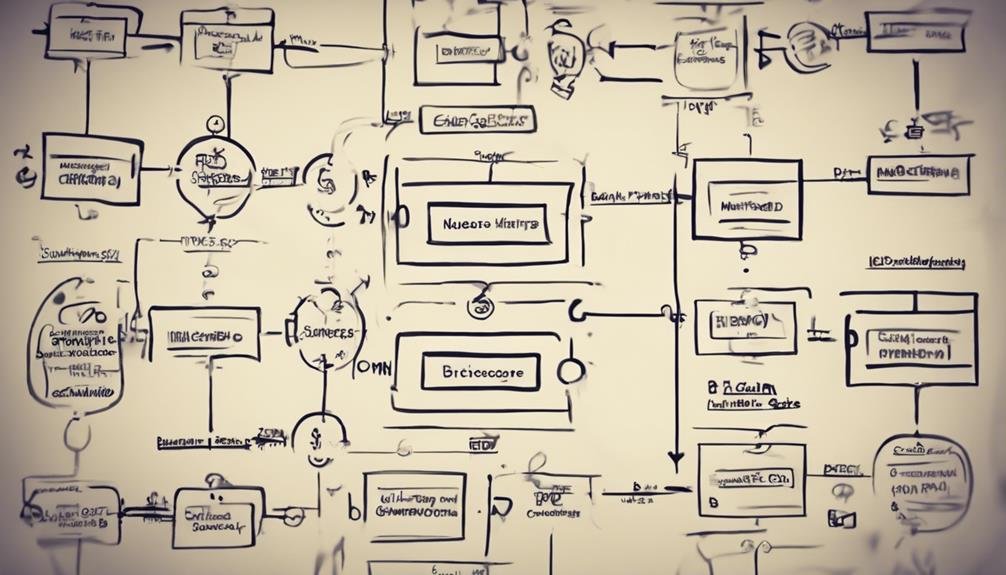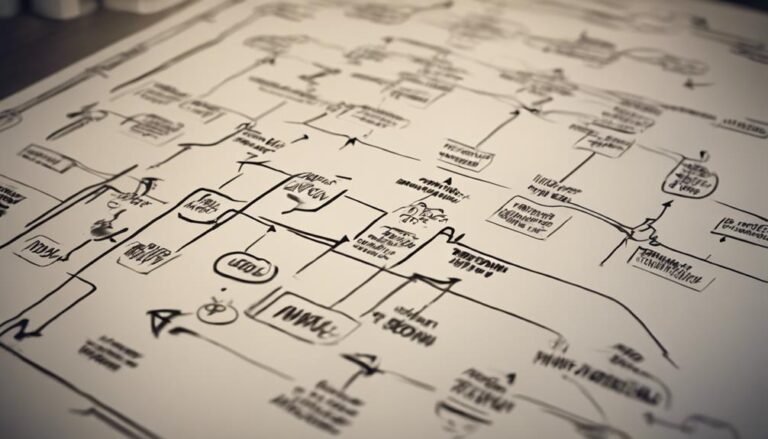BPMN Introduction for Analysts
In the realm of business process management, Business Process Model and Notation (BPMN) serves as a standardized visual language that enables analysts to depict complex processes in a clear and structured manner.
Understanding the fundamentals of BPMN is paramount for analysts seeking to streamline operations and enhance efficiency within organizations.
By delving into the key elements of BPMN diagrams and adopting best practices in modeling, analysts can effectively analyze processes, collaborate with stakeholders, and leverage advanced techniques to drive informed decision-making.
Key Takeaways
- BPMN provides a visual framework for analysts to map, optimize, and streamline processes efficiently.
- Analysts can use BPMN diagrams to identify inefficiencies, track performance metrics, and suggest process improvements.
- Consistency, standardized symbols, and stakeholder engagement are crucial for effective BPMN communication.
- Process simulation and proactive analysis help analysts minimize risks and enhance process efficiency.
Understanding BPMN Fundamentals
In comprehending the foundational principles of BPMN, analysts must grasp the essential elements that form the framework for modeling business processes. Process mapping is a crucial aspect of BPMN, as it involves visually representing the sequence of activities within a process. This mapping allows analysts to understand the flow of tasks, decisions, and interactions involved in achieving a specific business goal.
Workflow design is another key component, focusing on the structuring of tasks and their interdependencies to optimize efficiency and effectiveness. By utilizing BPMN for process mapping and workflow design, analysts can create detailed visual representations that provide a clear overview of how activities are performed, who is responsible for each task, and the order in which they occur. This level of detail is essential for streamlining processes, identifying bottlenecks, and improving overall operational performance.
Understanding these fundamental concepts of BPMN is foundational for analysts aiming to enhance business process management practices.
Key Elements of BPMN Diagrams
An essential component to dissect within BPMN diagrams is the intricate interplay of key elements that encapsulate the structure and flow of business processes. These elements are crucial for achieving process automation and workflow optimization.
The following list outlines the key elements of BPMN diagrams:
- Flow Objects: Represent the various steps, activities, or events within a business process. These include tasks, gateways, and events that dictate the flow of the process.
- Connecting Objects: Arrows that show the sequence and direction of the flow between different flow objects, indicating how the process progresses.
- Swimlanes: Dividers that separate different participants, roles, or departments involved in the process, clarifying responsibilities and handoffs.
- Artifacts: Additional information or notes that provide clarity on specific aspects of the process, such as data objects, groups, or annotations.
Understanding these key elements is fundamental to creating BPMN diagrams that facilitate process automation and streamline workflow optimization.
BPMN Modeling Best Practices
Exploring effective strategies for BPMN modeling involves incorporating industry-specific nuances and leveraging key elements to optimize business processes efficiently. When adhering to modeling conventions, analysts ensure consistency and clarity in their BPMN diagrams. This includes using standardized symbols, following a logical flow, and maintaining a clean layout to enhance readability. By adhering to these conventions, analysts facilitate better communication and understanding among stakeholders involved in the process.
Another best practice in BPMN modeling is utilizing process simulation to test and validate the designed processes. Process simulation allows analysts to identify bottlenecks, optimize resource allocation, and predict the impact of potential changes before implementing them in the actual business environment. This proactive approach helps in minimizing risks and maximizing the efficiency of the business processes.
Analyzing Processes With BPMN
Efficient analysis of business processes using BPMN involves dissecting intricate workflows to reveal underlying patterns and performance metrics. To effectively analyze processes with BPMN, consider the following key points:
- Identifying Process Inefficiencies: Utilize BPMN to map out the entire process flow and identify bottlenecks or areas where tasks are duplicated, leading to inefficiencies.
- Measuring Performance Metrics: Use BPMN to define key performance indicators (KPIs) within the process model to track metrics such as cycle time, throughput, and resource utilization.
- Analyzing Process Variability: BPMN allows analysts to model different scenarios and analyze how variations in process flows impact overall efficiency and performance metrics.
- Optimizing Process Design: By analyzing processes with BPMN, analysts can suggest improvements to streamline workflows, enhance process efficiency, and achieve better performance metrics.
Collaborating and Communicating With BPMN
Collaboration and communication in BPMN play pivotal roles in fostering a shared understanding of complex processes among stakeholders and facilitating efficient workflow management. Stakeholder engagement is essential for ensuring that all parties involved have a clear grasp of the processes being modeled using BPMN.
Effective communication strategies are necessary to convey process information accurately and comprehensively. Team collaboration is key to leveraging the full potential of BPMN, as it allows for different perspectives to be considered and integrated into the process modeling.
By actively involving stakeholders in the BPMN process, analysts can gather valuable feedback that can lead to process improvement and optimization. Encouraging open communication channels and promoting a collaborative environment can enhance the overall effectiveness of BPMN implementation within an organization.
Therefore, a focus on stakeholder engagement, communication strategies, and team collaboration is crucial for successful BPMN utilization and achieving streamlined process management.
Advanced BPMN Techniques for Analysts
Advanced BPMN techniques for analysts encompass a range of intricate strategies essential for optimizing processes. These include process optimization strategies, collaboration modeling techniques, and data flow visualization methods.
These advanced techniques delve deeply into refining and enhancing the efficiency of business processes. They enable analysts to create detailed models that accurately represent complex workflows and interactions within an organization.
Process Optimization Strategies
Utilizing sophisticated modeling techniques in BPMN, analysts can strategically enhance process performance through the implementation of targeted optimization strategies. When focusing on process optimization, analysts can consider the following key strategies:
- Identifying Bottlenecks: Pinpoint areas causing delays or inefficiencies to streamline the process flow.
- Leveraging Automation: Integrate automation opportunities to reduce manual tasks and increase efficiency.
- Implementing Parallel Processing: Optimize resource utilization by allowing tasks to be executed simultaneously.
- Continuous Monitoring and Improvement: Regularly analyze process performance metrics to identify areas for enhancement and implement iterative improvements.
Collaboration Modeling Techniques
Implementing collaborative modeling techniques in BPMN enables analysts to intricately map out interdependent processes with a focus on enhancing cross-functional integration and communication efficiency. Stakeholder engagement and process alignment are key aspects of collaboration modeling.
Analysts can utilize BPMN to visually represent how different stakeholders interact within a process, ensuring that all parties are aligned towards common goals. Communication strategies play a vital role in collaboration modeling, facilitating effective team collaboration by clearly outlining responsibilities, handoffs, and decision points.
Data Flow Visualization Methods
Effective data flow visualization methods in BPMN provide analysts with a comprehensive understanding of how information moves through processes, aiding in the identification of bottlenecks and optimization opportunities. To enhance process efficiency and streamline data transformation, analysts can utilize the following visualization techniques:
- Swimlanes: Clearly segregate responsibilities and roles within a process.
- Data Objects: Represent the flow and transformation of data throughout the process.
- Message Flows: Illustrate communication between different parts of a process.
- Association: Link additional information to activities, events, or data objects.
Conclusion
In conclusion, mastering BPMN fundamentals, understanding key elements, and implementing best practices are crucial for analysts to effectively model, analyze, and communicate processes. As analysts delve into advanced BPMN techniques, they can enhance their skills and contribute to efficient process management.
How can analysts leverage BPMN to optimize organizational workflows and achieve operational excellence?







